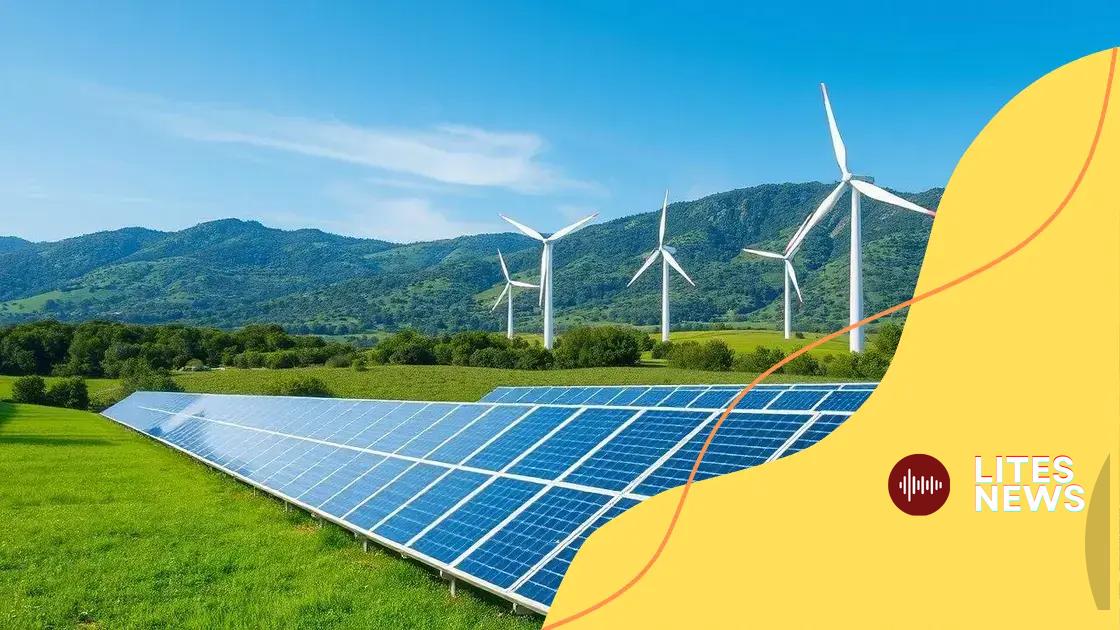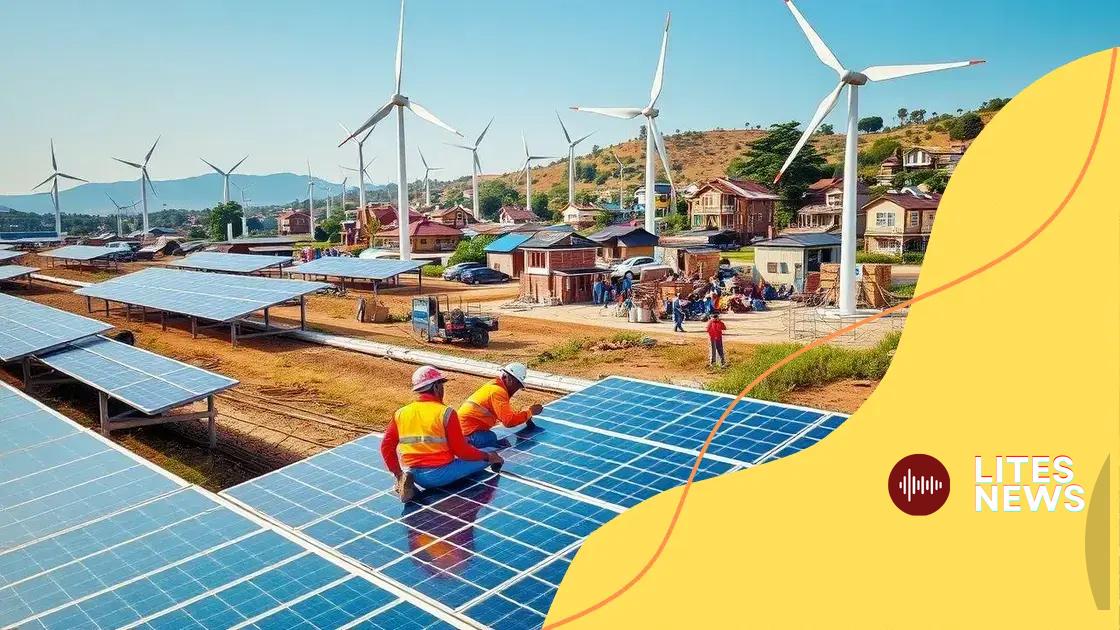Renewable energy subsidies: how they can transform your future

Renewable energy subsidies are financial incentives provided by governments to promote clean energy adoption, drive job creation, and stimulate economic growth while facing challenges like funding limitations and regulatory complexities.
Renewable energy subsidies are increasingly shaping our approach to sustainability. Have you ever wondered how these financial incentives could influence our planet’s future? Let’s dive into their significance and potential.
Understanding renewable energy subsidies
Understanding renewable energy subsidies is essential for grasping how governments are trying to encourage sustainable practices. These financial incentives make it easier for individuals and companies to invest in clean energy technologies.
Subsidies can come in many forms, including tax credits, grants, and rebates. They help lower the upfront costs associated with renewable energy, making it more accessible to a broader audience. As a result, we see more people considering options like solar panels or wind turbines.
The different types of renewable energy subsidies
There are various types of subsidies that support the growth of renewable energy. These can significantly affect the rate of adoption. Here are some key types:
- Tax credits: Reduce the amount of tax owed by individuals or businesses investing in renewable energy.
- Grants: Provide direct funding to help offset the costs of renewable energy projects.
- Feed-in tariffs: Guarantee fixed payments for energy produced from renewable sources.
- Rebates: Offer refunds on renewable energy products after purchase.
These subsidies play a crucial role in making renewable energy sources competitive with fossil fuels. By reducing financial barriers, they help accelerate the transition towards a cleaner energy future.
Benefits of renewable energy subsidies
The benefits of these subsidies extend beyond just financial aspects. They can lead to increased energy independence and lower greenhouse gas emissions. As more renewable energy systems are installed, reliance on fossil fuels diminishes, which is an essential step in combating climate change.
Moreover, renewable energy subsidies can stimulate job creation in the energy sector. As the demand for clean energy grows, new jobs are generated in manufacturing, installation, and maintenance of renewable energy technologies. This shift not only supports the economy but also promotes a healthier environment.
Understanding the mechanics behind renewable energy subsidies is vital for anyone interested in the future of sustainable energy. By acknowledging the importance of these financial aids, we can better advocate for policies that support a greener world.
The role of government in promoting renewables
The role of government in promoting renewables is crucial for achieving a sustainable energy future. Governments at all levels have the power to influence energy markets and encourage the adoption of clean energy technologies. This support can take many forms, including legislation, funding, and public outreach.
One primary way governments promote renewables is through policy frameworks. These policies set goals for renewable energy usage, provide incentives, and create standards to help manage energy production. Clear policies can guide investments toward clean energy sources while reducing reliance on fossil fuels.
Incentives for renewable energy adoption
Incentives play a significant role in making renewable energy projects appealing. Many governments offer:
- Tax credits: These reduce the taxes owed by individuals or businesses that invest in renewable energy.
- Grants: Financial assistances that help cover project costs for installing renewable energy systems.
- Subsidies: Direct financial support that lowers the cost of energy production from renewables.
- Loans: Low-interest loans to help businesses and homeowners afford renewable energy systems.
These incentives lower the barriers to entry, making it easier for individuals and businesses to adopt renewable technologies. As a result, there is often an increase in solar panel installations and wind turbine development.
Public awareness and education
Another essential role of government is to promote public awareness and education about renewable energy. By informing citizens about the benefits of clean energy, governments can foster a culture of sustainability. Programs that educate the public can lead to a better understanding of the importance of renewables and how they can contribute to reducing carbon emissions.
Furthermore, governments can partner with schools, non-profits, and businesses to expand the reach of these educational initiatives. By encouraging discussions about renewable energy, they can inspire individuals and communities to take action towards a greener future.
Overall, the government’s involvement in promoting renewables is vital for driving the transition to a sustainable energy landscape. By creating supportive policies, offering incentives, and raising public awareness, they pave the way for a cleaner and healthier environment.
Economic benefits of renewable energy subsidies

The economic benefits of renewable energy subsidies are significant and far-reaching. These financial incentives help transform the energy landscape while boosting local economies. By lowering the cost of renewable technologies, subsidies enable more individuals and businesses to invest in clean energy solutions.
One of the primary advantages is job creation. The renewable energy sector has been a remarkable source of employment. As investments increase, many new jobs emerge in manufacturing, installation, and maintenance of renewable energy systems. These jobs often pay well and provide stable employment opportunities.
Impact on local economies
Renewable energy projects can have a positive ripple effect on local economies. When new projects are developed, communities benefit from:
- Increased investment: Local governments can attract investments that provide funds for infrastructure and public services.
- Energy independence: Reducing reliance on imported fuels keeps money within the community, promoting local businesses.
- Tourism opportunities: Renewable energy facilities, like wind farms and solar parks, can attract visitors interested in sustainability.
The growth of green technologies also stimulates innovation. As the demand for renewable energy solutions increases, businesses are motivated to develop new products and services, leading to technological advances.
Lower energy costs
Another advantage is the potential for lower energy costs in the long run. By investing in renewable energy, communities can reduce their energy bills and reliance on fluctuating fossil fuel prices. Once renewable energy projects are established, they typically have lower operating costs than traditional energy sources.
This cost efficiency can provide significant savings for households and businesses alike. When energy prices decrease, consumers have more money to spend on goods and services, which helps stimulate the overall economy.
Ultimately, the economic benefits of renewable energy subsidies extend beyond job creation and savings. They can revitalize communities, promote innovation, and contribute to a more sustainable and resilient economy.
Challenges faced in subsidy implementation
The challenges faced in subsidy implementation can significantly impact the effectiveness of renewable energy programs. While subsidies are designed to promote clean energy adoption, various obstacles can arise as programs are executed. Understanding these challenges is critical for improving policies and ensuring successful outcomes.
One major challenge is the allocation of funding. Governments often have limited budgets and must decide how to distribute resources among various programs. This can lead to inadequate funding for renewable energy projects, which, in turn, hampers their growth.
Complex regulatory environments
Another significant hurdle to overcoming is the complexity of regulatory environments. Each state or country may have different rules and requirements, making it difficult for businesses to navigate the subsidy application process. This complexity can slow down project approvals and deter potential investors.
- Bureaucratic red tape: Lengthy approval processes can frustrate stakeholders.
- Varying laws: Differences in state or national regulations create confusion among investors.
- Unclear guidelines: Lack of straightforward instructions can discourage applications.
Additionally, there may be issues related to public perception. Some individuals oppose subsidies for renewable energy, believing they unfairly benefit certain companies or increase tax burdens. This opposition can lead to political challenges, making it harder to maintain support for subsidy programs.
Market fluctuations
Market fluctuations can also impact subsidy effectiveness. Changes in fossil fuel prices can affect the competitiveness of renewable energy sources, which can lead to debates about whether subsidies are still necessary. For instance, if fossil fuel prices drop significantly, the need for additional support for renewables may come into question.
Finally, the lack of long-term commitment can undermine the potential success of renewable energy subsidies. If governments change their policies frequently or fail to extend programs that show promise, it can create uncertainty among investors and developers.
Addressing these challenges requires ongoing dialogue among stakeholders, including governments, businesses, and the public. By working together, we can find solutions that enhance the viability of renewable energy subsidies and ensure sustainable energy growth for the future.
Future outlook for renewable energy funding
The future outlook for renewable energy funding appears promising, as countries and organizations increasingly recognize the importance of clean energy. With growing awareness of climate change and environmental issues, more investments are expected to flow into this vital sector.
While challenges exist, governments worldwide are starting to take significant steps toward sustainable energy financing. This commitment to supporting renewables can be seen through increased budgets for renewable projects, aimed at fostering innovation and ensuring a greener future.
Emerging trends in funding
Several trends are shaping the future of renewable energy funding:
- Private sector investment: More companies are investing in renewable energy projects, driven by consumer demand for sustainable practices.
- Green bonds: Financial instruments designed to fund projects with positive environmental impacts are gaining popularity.
- Public-private partnerships: Collaborations between governments and private entities can enhance funding resources, making large-scale projects more feasible.
- Technology advances: Innovations in renewable technologies often lower costs and attract new funding sources.
As these trends continue to grow, the financial landscape for renewable energy is likely to transform significantly.
International cooperation
International cooperation is another critical factor influencing the future of renewable energy funding. Countries are increasingly collaborating on collective sustainability goals. Global initiatives are aiming to share knowledge, resources, and financial support for renewable projects.
Such partnerships can help countries with fewer resources access funding for clean energy endeavors while promoting a unified approach to tackling climate challenges.
Overall, the outlook for renewable energy funding is bright, with increasing investments expected to drive innovation and sustainability. As public and private sectors unite, the transition to clean energy will gain momentum, paving the way for a healthier planet.
FAQ – Frequently Asked Questions about Renewable Energy Subsidies
What are renewable energy subsidies?
Renewable energy subsidies are financial incentives provided by governments to promote the adoption and development of clean energy technologies.
How do subsidies benefit the economy?
Subsidies stimulate job creation in the renewable sector, attract investments, and can lead to lower energy costs for consumers.
What challenges do governments face in implementing these subsidies?
Challenges include limited funding, complex regulations, market fluctuations, and public perception issues.
What is the future outlook for renewable energy funding?
The future looks promising with increasing investments, emerging trends in funding, and greater international cooperation on sustainable energy initiatives.





